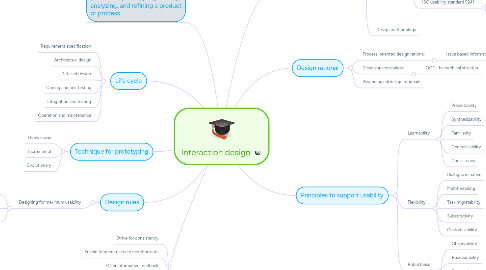Interaction design
by Mimi fatihah


1. Life cycle
1.1. Requirement specification
1.2. Archirectual design
1.3. Detailed design
1.4. Coding and unit testing
1.5. Integration and testing
1.6. Operation and maintenance
2. Technique for prototyping
2.1. Throw-away
2.2. Incremental
2.3. Evolutionary
3. Golden rules and heuristics
3.1. Strive for consistency
3.2. Enable frequent users to use shortcuts
3.3. Offer informative feedback
3.4. Design dialogs to yield closure
3.5. Offer error prevention and simple error handling
3.6. Permit easy reversal of actions
3.7. Support internal locus of control
3.8. Reduce short-term memory load
4. Design rules
4.1. Designing for maximum usability
4.1.1. Principles of usability
4.1.2. Standards and guidelines
4.1.3. Design patterns
5. Iterative design is a design methodology based on a cyclic process of prototyping, testing, analyzing, and refining a product or process.
6. Usability engineering
6.1. ISO usability
6.1.1. Usability specification
6.1.1.1. usability attribute/principle
6.1.1.2. measuring concept
6.1.1.3. measuring method
6.1.1.4. now level/ worst case/ planned level/ best case
6.1.2. ISO usability standard 9241
6.1.2.1. effectiveness
6.1.2.2. efficiency
6.1.2.3. satisfaction
6.2. Design methodology
7. Design rational
7.1. Process-oriented design rational
7.1.1. Issue based information system(IBIS)
7.2. Design space analysis
7.2.1. QOC –hierarchical structure
7.3. Psychological design rationale
8. Principles to support usability
8.1. Learnability
8.1.1. Predictability
8.1.2. Synthesizability
8.1.3. Familiarity
8.1.4. Generalizability
8.1.5. Consistency
8.2. Flexibility
8.2.1. Dialogue initiative
8.2.2. Multithreading
8.2.3. Task migratability
8.2.4. Substitutivity
8.2.5. Customizability
8.3. Robustness
8.3.1. Observability
8.3.2. Recoverability
8.3.3. Responsiveness
8.3.4. Task conformance

